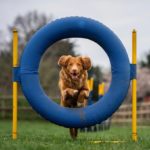Agility training is a great way to build a bond between you and your dog and improves their endurance, coordination, and flexibility.
However, agility training and equipment can be expensive, so if you’re looking to make your own, you’ve come to the right place.
In this article, I will provide you with a step-by-step guide on how to make a dog agility tunnel.
Let’s get started.

Before I get into the step-by-step guide on how to make a dog agility tunnel, you will first need to understand some basics of an agility tunnel.
What Is The Diameter Of A Dog Agility Tunnel?
The diameter of a dog agility tunnel is usually 24 inches or 22 to 26 inches in diameter. You might want to adapt the agility tunnel to accommodate for your dog’s size, but it shouldn’t be smaller than this as you don’t want them to struggle to get through the tunnel at any point.
How Long Are Dog Agility Tunnels?
Typically speaking, the minimum standards for a competition dog agility tunnel is 10 to 20 feet long.
It’s good practise to get your dog training in a tunnel that is the same size as you’d find at a competition. However, if you have no intention of competing with them then you can make your agility tunnel as long or as short as you like.
A Guide On How To Make A Dog Agility Tunnel
Equipment That You Will Need
- A pop-up laundry hamper (or several, depending on how long you want the tunnel to be)
- A needle
- Scissors
- Heavy duty thread
- Landscape fabric pins
Instructions
Step One – Cut Out The Bottom Of The Pop-up Laundry Hamper
To begin making a dog agility tunnel, you will need to open the pop-up laundry hamper or hampers if you’re using several. Using a sharp pair of scissors, cut out the bottom circle of the hamper and ensure that there are no sharp edges that could cut your dog.
Repeat this process with as many pop-up laundry hampers as you like to make the tunnel of your desired length.
Step Two – Thread The Needle
Next, you will need to thread the needle with a heavy duty thread that isn’t likely to snap. This is important, as it needs to be able to withstand the test of time and your dog running through the tunnel over and over again.
You will need to pull each end of the thread together and make a knot, as this double layer will work to secure the stitches.
Step Three – Stitch The Hamper
Now, it’s time to stitch the hampers. Place the hamper(s) end to end. Begin stitching with the needle on one edge of the first hamper, from the outside going in. Thread the needle into the next hamper from the inside and take the needle to the outside.
Step Four – Secure The Tunnel
Bring the tunnel onto your lawn. You will need to secure it to the desired location and position with fabric stakes, placing them through the hampers and securing your dog agility tunnel into the ground.
Step Five – Start Training Your Dog With Your Tunnel
Once you have safely secured the dog agility tunnel into the ground, you can begin training your dog with it.
Enjoy!
Important Considerations When Making A Dog Agility Tunnel
Opt For Durable Fabric
When you’re making a dog agility tunnel out of a laundry hamper, you should opt for one that is made with durable nylon material. The more durable the fabric, the less time you will have to spend repairing your agility tunnel.
A durable fabric will ensure that your dog’s sharp nails won’t tear up or damage the tunnel as they run through it.
Opt For Durable Thread
There’s no getting away from the fact that agility training can cause wear and tear to your equipment. However, in the same way that you should opt for a durable fabric, you should also opt for durable thread.
The thread is what will hold your agility tunnel together, so it needs to be able to withstand your dog’s frequent training. If you don’t choose the right kind of thread, you will end up with a tattered agility tunnel that falls apart easily.
If you haven’t got thick enough thread, you could always opt for fishing line. Fishing line comes in lots of different thicknesses and strengths, and can work as well if not better than thread in this circumstance.
Make Regular Maintenance Checks
The thing about making a DIY dog agility tunnel is that you’re likely to need to make regular maintenance checks to ensure that it’s safe. Always check that the fabric stakes are secure in the ground between every use, and that the stitching is holding up well.
It’s natural for there to be some wear and tear, especially if you’re frequently training your dog. You will also need to check the stitching between the hampers before each use to ensure that they are going to be able to withstand the training session.
Secure Fabric Stakes
Before you start training your dog with this agility tunnel, make sure that the fabric stakes are secure in the ground and aren’t sticking out of the ground. If you fail to do this, when your dog runs through the tunnel at high speed, they could be injured.
Ensuring that you make the necessary checks is essential to your dog’s safety, and will prevent them from accidentally injuring themselves.
Benefits Of Making Your Own Dog Agility Tunnel
Making Your Own Agility Tunnel Can Be Cheaper
If you have a few laundry hampers lying around the house, then making your own agility tunnel is a free venture. Alternatively, you can buy laundry hampers that are relatively inexpensive for your project.
It’s A Fun Project
Being involved in every step of your dog’s agility training is important for a lot of dog owners. Making your own dog agility training tunnel is a fun project, and the result will be much more rewarding than simply buying one straight off the bat.
Inexpensive Way Of Testing The Water
When you first start agility training with your dog, you don’t yet know your dog’s natural ability and how your dog is going to respond to this type of training.
They might love it, or they might hate it and be unresponsive. If you buy all the gear with no idea, then you could be blindly buying equipment unnecessarily. Making your own agility tunnel is a good way of testing the water to see if your pooch actually enjoys agility training.
You can’t walk before you run! You don’t want to be in a position where you’ve wasted money because your dog doesn’t get the use out of the equipment.
Once you gain a better perspective and gauge whether they enjoy agility and you can see yourself going further in competitions, then you might want to invest in better quality equipment.
In Summary
Making your own dog agility tunnel is great for cutting the cost of agility training.
Hopefully after reading this article you will have a better idea of how to make your dog an agility tunnel!
Enjoy and good luck with your training!
- 8 Signs That Your Dog Is In Heat - November 8, 2022
- Why Is My Dog Whining Whilst Carrying A Toy In Their Mouth? - August 17, 2022
- Reasons Why Your Dog’s Poop Is White And What To Do About It - August 17, 2022









